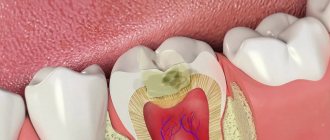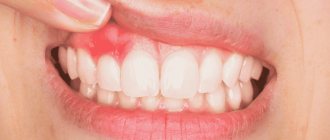Pain after caries treatment: normal or pathological?
Pain after treatment and filling does not always indicate pathology. In 70% of cases, it is the norm, especially if you come to the doctor with advanced, deep caries, progressing or developing into pulpitis.
Mild pain traditionally occurs due to mechanical irritation of the treated tooth - biting on it, chewing hard food, pressing with a finger or a toothpick. This is due to the close fit of the bottom of the carious cavity to the pulp and nerve of the tooth. When you press on the coronal part, the filling puts even more intense pressure on the pulp, which provokes pain. Normally, they are not too pronounced and rather resemble a dull “bone” pain.
There is no need to worry about such pain - over time, your health will definitely return to normal, and the tooth will stop bothering you even with pressure or irritation. Neutralization of uncomfortable sensations is associated with the production of a protective layer of dentin by the pulp, which, as it were, “distances” it from the base of the filling. This process may take up to 2 months.
The first cause for concern is the manifestation of nagging or acute but constant pain, which does not depend on external factors.
Toothache cannot be tolerated. “Muffling” it with strong analgesics is also not recommended, especially if the nature of the symptom is unknown to you.
Leave your phone number. The clinic administrator will call you back.
By leaving a request on the site, you consent to the processing of personal data
Make an appointment
Initial consultation with a dentist
For free!
After filling the cervical part of the tooth (the one located at the junction with the gum), a transient increase in sensitivity is likely. Your tooth can react to cold and hot, as well as sweet and sour. Pay attention to the presence of a “step” or depression between the base of the filling and the original tooth tissue. If you notice an unevenness on the surface, contact your dentist immediately, as this may subsequently lead to inflammation or exposure of the root.
Another variant of the norm may be pain that occurs against the background of:
- Individual response to treatment of dental caries (especially drilling, grinding and polishing);
- X-raying the tooth with special equipment;
- Irritation of soft tissues due to the need to drill out a deep cavity (usually with pulpitis).
Discomfortable sensations go away on their own after 1-8 weeks, depending on the original problem and the individual characteristics of the body.
Increased sensitivity of teeth during deep stages of caries
Caries develops gradually - at first, a person may not even suspect that he has this problem if he does not practice regular dental examinations. There are four stages of the carious process:
- the so-called “chalk stain”, when the enamel changes color and acquires a darker shade - grayish or milky;
- superficial: teeth begin to react to hot, cold, sour, etc., the stain becomes rough;
- medium caries, when carious cavities increasingly destroy dentin, and pain occurs more often and is felt more strongly;
- deep: the carious process begins to affect the pulp, a cavity is formed bordering the dental nerve.
If caries is not treated, its complications are inevitable, for example, pulpitis, periodontitis, and as a result, teeth can simply be lost.
When is there a reason to worry?
Sometimes doctors recommend that their patients take painkillers after treatment, as they objectively assess the complexity and assume temporary side effects. But symptom relief does not take longer than 3-4 days even after tooth extraction. You must understand that pain is not an enemy at all, but a benefit that signals a problem. And if it appears on an ongoing basis for a week or more, this is a good reason to visit a specialist.
Pay close attention to any accompanying symptoms:
- Fever or slight but constant increase in temperature;
- Bleeding gums around the treated tooth;
- Acute attacks that occur at night;
- A significant increase in sensitivity, encouraging you to completely abandon potential irritants in the form of ice cream or hot tea;
- Numbness of the soft tissues of the jaw at the site of the procedures;
- Darkening or blueness of the gums;
- General malaise and weakness without objective reasons.
Constant aching pain with periodic exacerbations can be associated with overdrying or underdrying of the formed cavity before filling. Both mistakes by the doctor are fraught with complications. When overdrying, persistent irritation of nerve endings can occur, leading to death. If it is not dried enough, the adhesive (sticky material) cannot be absorbed into the dentin, and when the filling shrinks, it comes off from the bottom of the cavity, creating a discharged space here like a vacuum. This also irritates the nerve endings (in professional language the phenomenon is called “debonding”).
In both cases, there is no point in enduring pain for more than a week. Perhaps after 7 days it will really stop bothering you, and the reason for going to the dentist will disappear by itself. But if a week after treatment has passed and the symptom persists, you should immediately visit a doctor.
How to relieve toothache yourself?
- If pain occurs, the right solution would be to take special painkillers. Dentists advise their patients Nurofen, Ketanov, Dexalgin, Baralgin. You can also take regular analgin in tablets. Specialists at Dr. Granov's clinic strongly recommend that you stop taking aspirin and medications containing high concentrations of acetylsalicylic acid. The analgesic effect from them is small, but in high dosages the substance provokes complications, sometimes very dangerous for general health.
- Temporarily stop chewing food on the affected side. Perhaps the symptom is associated specifically with biting - that is, mechanical irritation.
- Under no circumstances use “grandmother’s methods” in the form of heating, lotions or compresses. The procedure can significantly aggravate the current situation and even obviously complicate the process of subsequent treatment, if necessary.
- Antibiotics should not be taken without a doctor's prescription. The selection of antibacterial drugs is a responsible step in which the doctor carefully weighs the benefits and risks. Unauthorized use of antibiotics can lead to unpredictable consequences.
- You can purchase a natural product at the pharmacy - dental drops. It contains plant extracts of valerian, mint and camphor. Soak a tight cotton swab in the solution and apply it to the sore tooth. Change the tampon every 10 minutes until pain subsides.
- You can help yourself by rinsing with decoctions of soothing herbs: mint, lemon balm, chamomile.
Relief from pain
If this symptom bothers you greatly or is accompanied by edema or swelling, then contact your dentist. Experienced doctors at the Aurora Star clinic will quickly identify the cause of pain and make every effort to eliminate it. Sometimes this requires simply filling the tooth again (for example, if it was underfilled or overfilled). If complications occur, such as periodontitis, then surgical treatment will be required - an incision to remove pus.
Sometimes pain is a natural phenomenon after treatment for dental diseases. But everyone has their own pain threshold. If this symptom bothers you greatly, your doctor will help you choose the appropriate painkillers. At the Aurora Star clinic you can get rid of the consequences of poor-quality dental treatment, and at the same time, pain. Experienced dentists, modern equipment and a pleasant pricing policy await you.
In what cases is it important to visit a doctor?
Visit a specialist urgently if you have:
- Acute toothache;
- Pain combined with bleeding gums;
- Dull pain that sharply worsens when eating cold or hot food (this may indicate untreated chronic pulpitis);
- The temperature has risen;
- Discharge from the gums or changes in the gum tissue are observed.
If you don't trust the dentist who treated your tooth before symptoms began, find a better professional. The specialists at Dr. Granov’s clinic are ready to help you with dental treatment and correct the mistakes of others.
We are responsible for the health of our patients and choose progressive, safe, effective treatment methods.
Allergic pain reactions
In rare cases, the injected filling materials can cause an allergic reaction in the patient, which then causes toothache. Such allergies are very rare today, since holes are rarely filled with amalgam (the professional name for one of the filling materials whose properties take advantage of the ability of mercury to dissolve certain metals), but rather with modern light-curing composite filling materials.
What to do if your teeth hurt after filling
At Dr. Martin's dentistry, treatment for pain in a filled tooth begins with diagnosis. The most informative method is an x-ray. All processes occurring inside the canals and other areas of the tooth will be reflected in the image.
When pathological processes are confirmed, the tooth is depressurized. The filling is removed, the root canals are re-cleaned and proper treatment is carried out. If the instrument breaks, the foreign object is removed using special devices.
In each case, the manipulation scheme is determined individually. Treatment ends with re-filling and restoration of the dental crown. The dentist may prescribe medication to prevent or eliminate the inflammatory process. A follow-up visit is required to take a control x-ray.
Experts' opinion
The effectiveness of the ASEPTA series products has been proven by multiple clinical trials conducted in the country's leading research institutes.
For example, a study of the clinical effectiveness of treatment and prophylactic agents from the Asepta line in the treatment of inflammatory periodontal diseases, conducted by A.I. Grudyanov, I.Yu. Alexandrovskaya, V.Yu. Korzunina in the Department of Periodontology of the Central Research Institute of Dentistry and Maxillofacial Surgery of Rosmedtekhnologii, Moscow, made it possible to identify the fairly high effectiveness of the Asepta gum balm and the Asepta mouth rinse for moderate periodontitis. The use of Asepta mouth rinse for inflammation also turned out to be quite effective. In addition, no phenomena of mucosal irritation or brown staining of fillings were recorded. This indicates that the use of this rinse for a two-week period provides an obvious clinical effect in the absence of negative side effects.
Consumer Reviews
Mrs. Doubtfire about Asepta Active mouth rinse (irecommend.ru):
“When I was faced with a serious gum problem, this rinse was recommended to me by a dental surgeon.
Asepta Active mouthwash is a medical product and is sold only through the pharmacy chain. The instructions recommend taking breaks in use. Personally, I use it in courses and during exacerbations of gum inflammation. I've been using it for about 2 years.
The mouthwash is minty, pleasant, slightly astringent. Improvement is felt from the first use. Bottle volume 150 ml. Manufacturer: Russia, St. Petersburg. A convenient measuring cup is included.
You can (better) buy it as a set, which also includes balm and toothpaste, which comes as a gift.
I’m very happy that such products from a domestic manufacturer have appeared!”
julia-06 about Asepta Active mouth rinse (irecommend.ru):
“A very good rinse for problem gums.
She had never encountered the problem of bleeding gums, but at her next visit to the dentist she noticed that when she only lightly touched her gums, they began to bleed. So the dentist gave me a mini version of Paradontax toothpaste and advised me to use a mouthwash after brushing my teeth. Mom bought Asepta active mouth rinse.
For some reason I used to be very skeptical about such remedies, but as it turned out, in practice it helps very well. My problem went away completely, my gums stopped bleeding. I don’t even want to read the ingredients and go into its details, it’s unlikely that everything is super natural, but since it helps, I give the mouthwash a solid 5 points. Of course, each case is individual, but I will recommend it based on my experience. And the price of the rinse aid is quite reasonable.”









